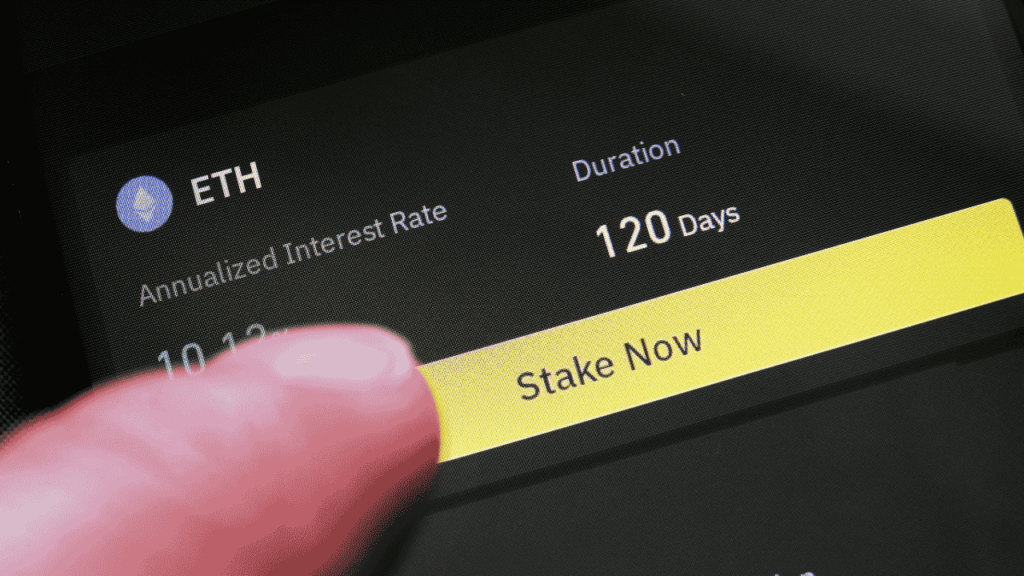Crypto staking allows investors to earn rewards by participating in the validation of transactions on a blockchain network. Choosing the right exchange is crucial for maximizing staking benefits. But as with all cryptocurrency investing it is risky and there is chance you can lose all your money.
When you stake your crypto-assets on a crypto exchange, you lock them up to support a blockchain network’s operations, such as validating transactions or enhancing network security. This process is typically associated with Proof of Stake (PoS) blockchains like Ethereum, Cardano, and Solana. On the exchange, you select a staking program for a supported cryptocurrency. Your assets are then locked for a specified period, or in some cases, they may be available for flexible staking.
While staked, your assets contribute to the network’s functionality, and you earn rewards, usually in the form of the same cryptocurrency. Rewards depend on the amount staked, the staking duration, and the network’s reward rate, often expressed as an Annual Percentage Yield (APY). However, staking involves risks. The locked funds are illiquid, so you cannot access them during the staking period.
Additionally, if the crypto’s price drops, the value of your stake decreases. Some networks also implement penalties, known as slashing, which could result in losing a portion of your stake due to validator errors. Crypto exchanges simplify staking by managing technical details and pooling user assets but charge fees for the service. Despite the risks, staking is a popular way to earn passive income from idle crypto holdings.
Cryptocurrency Exchanges For Crypto Staking Compared
Here are some of the top crypto exchanges available to UK residents that offer staking services:
1. Kraken
- Overview: Kraken is one of the longest-running platforms in the industry, known for its robust security measures and a wide range of supported cryptocurrencies.
- Staking Features: Offers staking for various cryptocurrencies with competitive yields.
- Pros:
- 200+ supported coins.
- Low fees for active traders.
- High-quality educational guides and tools.
- Cons:
- Some trading features unavailable to UK users.
- High fees for credit and debit card purchases.
2. Coinbase
- Overview: Coinbase is a user-friendly platform ideal for beginners, offering a range of cryptocurrencies and staking options.
- Staking Features: Provides staking for cryptocurrencies like Ethereum (ETH), Cardano (ADA), and Solana (SOL).
- Pros:
- Easy-to-use interface.
- Educational resources for beginners.
- Secure storage options.
- Cons:
- Higher fees compared to some competitors.
- Limited customer service options.
3. Uphold
- Overview: Uphold is a multi-asset platform allowing users to trade cryptocurrencies, stocks, and precious metals.
- Staking Features: Offers staking for over 30 cryptocurrencies with varying annual percentage yields (APYs).
- Pros:
- Supports a wide range of assets.
- User-friendly interface.
- Crypto debit card with rewards.
- Cons:
- Higher spreads compared to some exchanges.
- Limited advanced trading features.
4. Crypto.com
- Overview: Crypto.com offers a comprehensive suite of crypto services, including trading, staking, and a crypto debit card.
- Staking Features: Provides staking with competitive interest rates, depending on the cryptocurrency and lock-up period.
- Pros:
- Extensive range of supported cryptocurrencies.
- Additional features like an NFT marketplace.
- Competitive fees.
- Cons:
- Complex fee structure.
- Customer support can be slow during peak times.
5. Gemini
- Overview: Gemini is a regulated cryptocurrency exchange known for its strong security measures and user-friendly platform.
- Staking Features: Offers staking for select cryptocurrencies, allowing users to earn rewards on their holdings.
- Pros:
- High-security standards.
- Intuitive mobile and web applications.
- Educational resources available.
- Cons:
- Limited selection of staking options.
- Fees can be higher than some competitors.
When selecting a crypto exchange for staking, consider factors such as the range of supported cryptocurrencies, staking rewards, fees, security measures, and the platform’s reputation. Always conduct thorough research to choose the platform that best aligns with your investment goals and risk tolerance.
How Crypto Staking and Stock Lending Are Similar
Crypto staking and stock lending share some similarities in how they allow investors to generate passive income from their holdings, but they function differently due to the nature of the assets involved. Here’s a comparison:
- Passive Income:
- Both activities let you earn a return on assets you already own without selling them.
- In crypto staking, you earn rewards (often in the form of the staked cryptocurrency).
- In stock lending, you earn interest when your shares are lent out to other market participants.
- Locking or Lending Assets:
- In both cases, your assets are put to work:
- Staking: Crypto is locked up to secure a blockchain and validate transactions.
- Stock Lending: Shares are lent to borrowers, often for short-selling or meeting regulatory requirements.
- In both cases, your assets are put to work:
- Risk Exposure:
- You maintain ownership of the asset (crypto or stock) but assume risks:
- Staking Risks: Price volatility, slashing penalties (in PoS systems), or network failures.
- Stock Lending Risks: Counterparty risk (the borrower might default) and missing out on shareholder benefits like voting rights or dividends.
- You maintain ownership of the asset (crypto or stock) but assume risks:

Richard is the founder of the Good Money Guide (formerly Good Broker Guide), one of the original investment comparison sites established in 2015. With a career spanning two decades as a broker, he brings extensive expertise and knowledge to the financial landscape.
Having worked as a broker at Investors Intelligence and a multi-asset derivatives broker at MF Global (Man Financial), Richard has acquired substantial experience in the industry. His career began as a private client stockbroker at Walker Crips and Phillip Securities (now King and Shaxson), following internships on the NYMEX oil trading floor in New York and London IPE in 2001 and 2000.
Richard’s contributions and expertise have been recognized by respected publications such as The Sunday Times, BusinessInsider, Yahoo Finance, BusinessNews.org.uk, Master Investor, Wealth Briefing, iNews, and The FT, among many others.
Under Richard’s leadership, the Good Money Guide has evolved into a valuable destination for comprehensive information and expert guidance, specialising in trading, investment, and currency exchange. His commitment to delivering high-quality insights has solidified the Good Money Guide’s standing as a well-respected resource for both customers and industry colleagues.
To contact Richard, please ask a question in our financial discussion forum.




